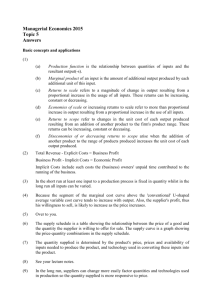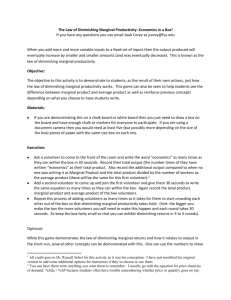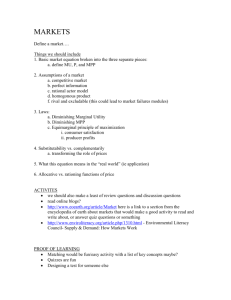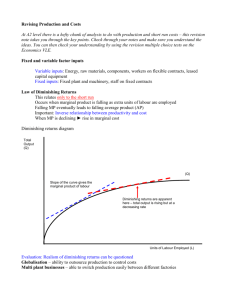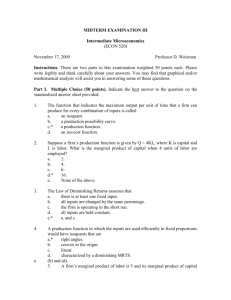Law of Variable Proportions - CII Institute of Logistics
advertisement
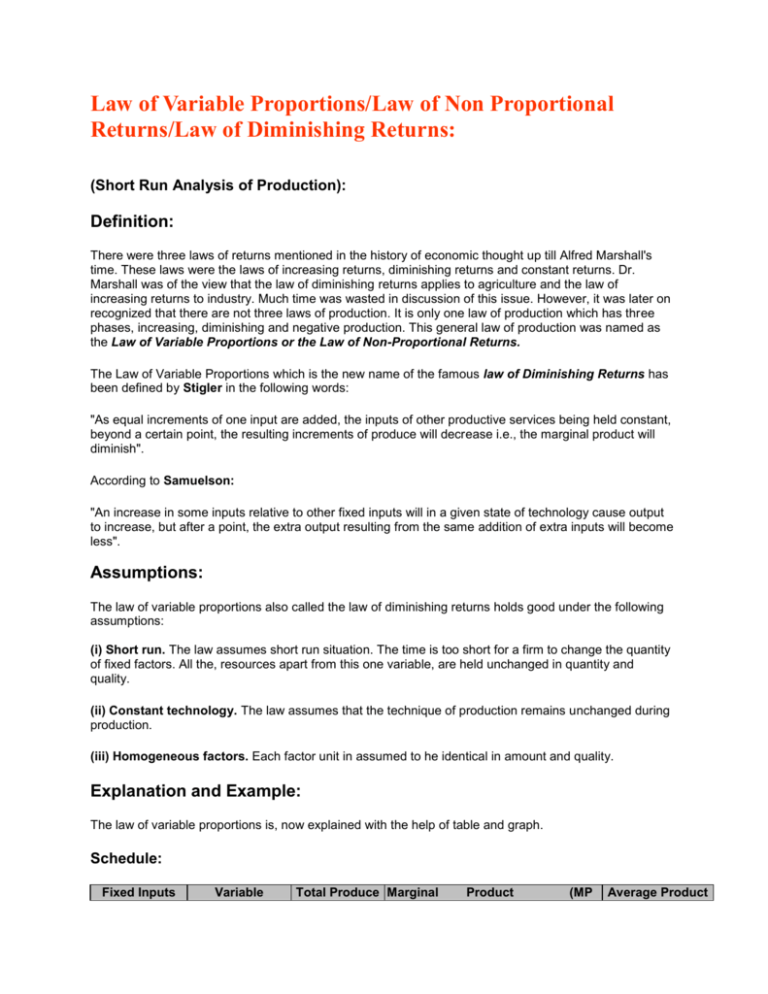
Law of Variable Proportions/Law of Non Proportional Returns/Law of Diminishing Returns: (Short Run Analysis of Production): Definition: There were three laws of returns mentioned in the history of economic thought up till Alfred Marshall's time. These laws were the laws of increasing returns, diminishing returns and constant returns. Dr. Marshall was of the view that the law of diminishing returns applies to agriculture and the law of increasing returns to industry. Much time was wasted in discussion of this issue. However, it was later on recognized that there are not three laws of production. It is only one law of production which has three phases, increasing, diminishing and negative production. This general law of production was named as the Law of Variable Proportions or the Law of Non-Proportional Returns. The Law of Variable Proportions which is the new name of the famous law of Diminishing Returns has been defined by Stigler in the following words: "As equal increments of one input are added, the inputs of other productive services being held constant, beyond a certain point, the resulting increments of produce will decrease i.e., the marginal product will diminish". According to Samuelson: "An increase in some inputs relative to other fixed inputs will in a given state of technology cause output to increase, but after a point, the extra output resulting from the same addition of extra inputs will become less". Assumptions: The law of variable proportions also called the law of diminishing returns holds good under the following assumptions: (i) Short run. The law assumes short run situation. The time is too short for a firm to change the quantity of fixed factors. All the, resources apart from this one variable, are held unchanged in quantity and quality. (ii) Constant technology. The law assumes that the technique of production remains unchanged during production. (iii) Homogeneous factors. Each factor unit in assumed to he identical in amount and quality. Explanation and Example: The law of variable proportions is, now explained with the help of table and graph. Schedule: Fixed Inputs Variable Total Produce Marginal Product (MP Average Product (Land Capital) 30 30 Resource (labor) 1 2 30 30 30 30 30 (TP Quintals) Quintals) (AP Quintals) 10 25 10 15 Increasing marginal return 3 4 5 6 7 37 47 55 60 63 12 10 8 5 3 Diminishing marginal returns 30 8 63 0 Negative marginal returns 30 9 62 -1 10 12.5 12.3 11.8 11.0 10.0 9.0 7.9 6.8 In the table above, it is assumed that a farmer has only 30 acres of land for cultivation. The investment on it in the form of tubewells, machinery etc., (capital) is also fixed. Thus land and capital with the farmer is fixed and labor is the variable resource. As the farmer increases units of labor from one to two to the amount of other fixed resources (land and capital), the marginal as well as average product increases. The total product also increase at an increasing rate from 10 to 25 quintals. It is the stage of increasing returns. The stage of increasing returns with the employment of more labor does not last long. It is shown in the table that with the employment of 3rd labor at the farm, the marginal product and the average product (AP) both fall but marginal product (MP) falls more speedily than the average product AP). The fall in MP and AP continues as more men are put on the farm. The decrease, however, remains positive up to the 7th labor employed. On the employment of 7th worker, the total production remains constant at 63 quintals. The marginal product is zero. if more men are employed the marginal product becomes negative. It is the stage of negative returns. We here find the behavior of marginal product (MP). it shows three stages. In the first stage, it increases, in the 2nd it continues to fall and in the 3rd stage it becomes negative. Three Stages of the Law: There are three phases or stages of production, as determined by the law of variable proportions: (i) Increasing returns. (ii) Diminishing returns. (iii) Negative returns. Diagram/Graph: These stages can be explained with the help of graph below: (i) Stage of Increasing Returns. The first stage of the law of variable proportions is generally called the stage of increasing returns. In this stage as a variable resource (labor) is added to fixed inputs of other resources, the total product increases up to a point at an increasing rate as is shown in figure 11.1. The total product from the origin to the point K on the slope of the total product curve increases at an increasing rate. From point K onward, during the stage II, the total product no doubt goes on rising but its slope is declining. This means that from point K onward, the total product increases at a diminishing rate. In the first stage, marginal product curve of a variable factor rises in a part and then falls. The average product curve rises throughout .and remains below the MP curve. Causes of Initial Increasing Returns: The phase of increasing returns starts when the quantity of a fixed factor is abundant relative to the quantity of the variable factor. As more and more units of the variable factor are added to the constant quantity of the fixed factor, it is more intensively and effectively used. This causes the production to increase at a rapid rate. Another reason of increasing returns is that the fixed factor initially taken is indivisible. As more units of the variable factor are employed to work on it, output increases greatly due to fuller and effective utilization of the variable factor. (ii) Stage of Diminishing Returns. This is the most important stage in the production function. In stage 2, the total production continues to increase at a diminishing rate until it reaches its maximum point (H) where the 2nd stage ends. In this stage both the marginal product (MP) and average product of the variable factor are diminishing but are positive. Causes of Diminishing Returns: The 2nd phase of the law occurs when the fixed factor becomes inadequate relative to the quantity of the variable factor. As more and more units of a variable factor are employed, the marginal and average product decline. Another reason of diminishing returns in the production function is that the fixed indivisible factor is being worked too hard. It is being used in non-optima! proportion with the variable factor, Mrs. J. Robinson still goes deeper and says that the diminishing returns occur because the factors of production are imperfect substitutes of one another. (iii) Stage of Negative Returns. In the 3rd stage, the total production declines. The TP, curve slopes 2 downward (From point H onward). The MP curve falls to zero at point L and then is negative. It goes below the X axis with the increase in the use of variable factor (labor). Causes of Negative Returns: The 3rd phases of the law starts when the number of a variable, factor becomes, too excessive relative, to the fixed factors, A producer cannot operate in this stage because total production declines with the employment of additional labor. A rational producer will always seek to produce in stage 2 where MP and AP of the variable factor are diminishing. At which particular point, the producer will decide to produce depends upon the price of the factor he has to pay. The producer will employ the variable factor (say labor) up to the point where the marginal product of the labor equals the given wage rate in the labor market. Importance: The law of variable proportions has vast general applicability. Briefly: (i) It is helpful in understanding clearly the process of production. It explains the input output relations. We can find out by-how much the total product will increase as a result of an increase in the inputs. (ii) The law tells us that the tendency of diminishing returns is found in all sectors of the economy which may be agriculture or industry. (iii) The law tells us that any increase in the units of variable factor will lead to increase in the total product at a diminishing rate. The elasticity of the substitution of the variable factor for the fixed factor is not infinite. From the law of variable proportions, it may not be understood that there is no hope for raising the standard of living of mankind. The fact, however, is that we can suspend the operation of diminishing returns by continually improving the technique of production through the progress in science and technology.


